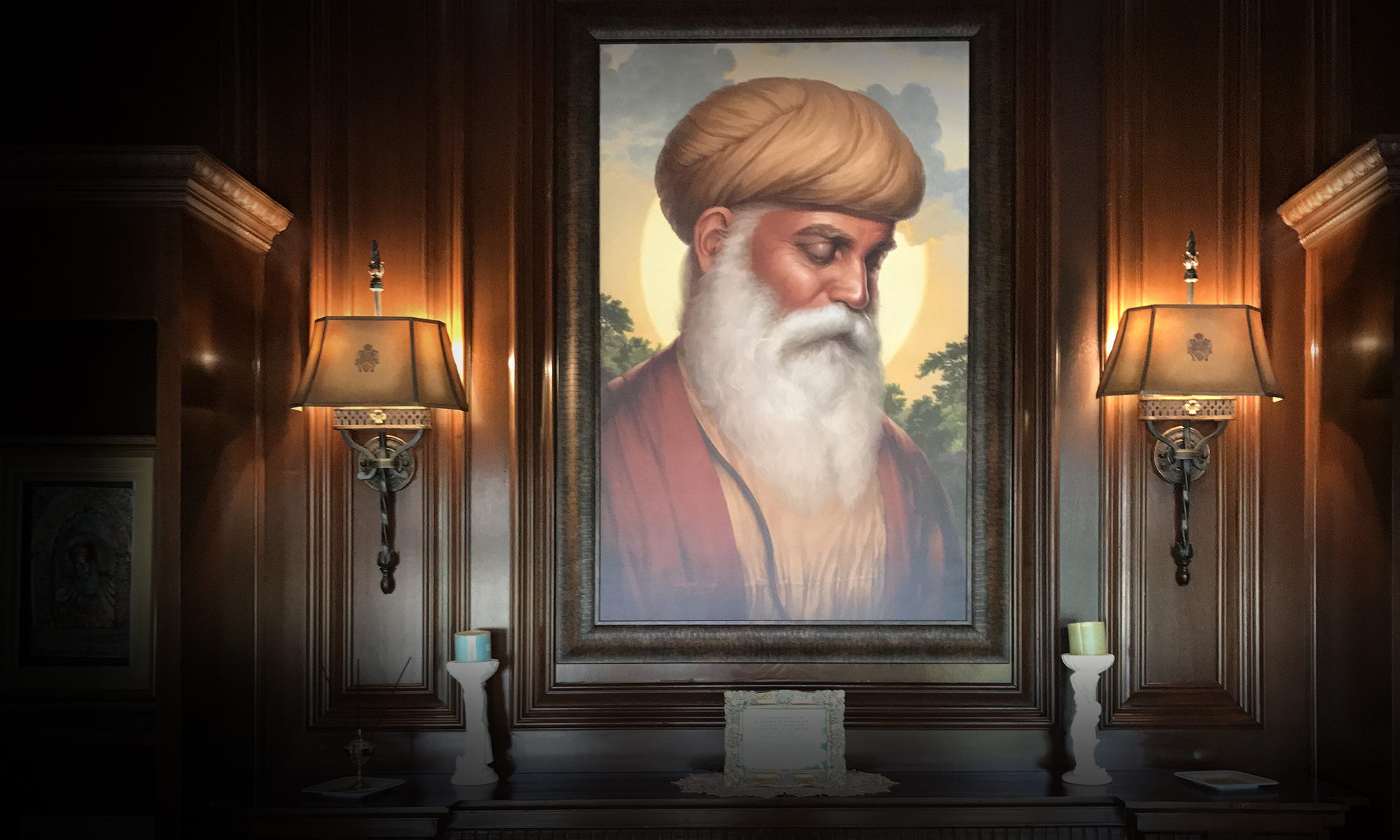“My salutations to the Adi Guru, to the Guru of all ages, to the True Guru, to the Guru Lord and Master.”
– Guru Arjun Dev ji (Guru Granth Sahib, 262)
My newest painting depicting Adi Guru – Guru Nanak Dev ji – is a reminder that through the Guru’s teachings we can illuminate the darkness in the mind. In this painting, Guru Nanak Dev ji carries and radiates Akal Purakh’s light, the way the sun radiates light and warmth on us all, and when we bathe in Guru Sahib’s warmth, we become warm ourselves.

Bhagat’s sikh art always captures sikh history and spirituality as authentically and as accurately as possible. His painting is a reminder to those beings, who are immersed in daily grind, to remember God at all times. Buy prints for inspiration to let God inside your heart.
The Sun is Consciousness
Adi Guru – Guru Nanak Dev ji is a mirror to my painting of Dashmesh Pita – Guru Gobind Singh ji. Guru Nanak Dev ji is portrayed with a Sun behind him whereas Guru Gobind Singh ji is portrayed with a Moon. Guru Nanak Dev ji tells us that both the Sun and Moon are made from the same Consciousness as we are, and that through the Guru’s teachings, this can be realized intimately.
ਰਵਿ ਸਸਿ ਦੇਖਉ ਦੀਪਕ ਉਜਿਆਲਾ ॥ ਸਰਬ ਨਿਰੰਤਰਿ ਪ੍ਰੀਤਮੁ ਬਾਲਾ ॥੪॥
In the Ravi, Sun, and in the Sassi, Moon, I see my Beloved’s light, totally all-pervading, totally one with everything.
ਕਰਿ ਕਿਰਪਾ ਮੇਰਾ ਚਿਤੁ ਲਾਇਆ ॥ ਸਤਿਗੁਰਿ ਮੋ ਕਉ ਏਕੁ ਬੁਝਾਇਆ ॥੫॥
By his grace, my mind has become immersed in him. My true guru has given me this understanding of my Beloved. (Guru Granth Sahib, 223)
Spiritual Mission
The first Guru of the Sikhs, Guru Nanak Dev ji was born in Punjab, in what is now known as Nankana Sahib, situated in modern day Pakistan. From a young age, he meditated a lot and in adulthood he set out to fulfill his purpose on Earth. Already trained as a trader, he travelled and traded, all the while spreading the message of Karta Purukh. He preached that to obtain the Creator one must learn to see the Creator inside oneself through devotional meditation.
Meditation Practice
Being a poet, a meditator and a teacher, Guru Nanak Dev ji described the process of meditation using rich metaphors and vibrant imagery.
In Pauri 38 of Jap ji Sahib, he writes –
ਜਤੁ ਪਾਹਾਰਾ ਧੀਰਜੁ ਸੁਨਿਆਰੁ ॥
Your ability to withdraw your Five Senses from the world is your Workshop. Your Patience makes you a Goldsmith.
ਅਹਰਣਿ ਮਤਿ ਵੇਦੁ ਹਥੀਆਰੁ ॥
Your Intelligence is your Anvil. Following the Vedas, Sacred Spiritual Texts, is your Hammer.
ਭਉ ਖਲਾ ਅਗਨਿ ਤਪ ਤਾਉ ॥
Blow through the Pipe the Fear of God, and increase the heat of the Body.
ਭਾਂਡਾ ਭਾਉ ਅੰਮ੍ਰਿਤੁ ਤਿਤੁ ਢਾਲਿ ॥ ਘੜੀਐ ਸਬਦੁ ਸਚੀ ਟਕਸਾਲ ॥
In your container of Love, pour in the molten gold that is Amrit, Timeless Quality of Consciousness, and mint the Gold coins of your Guru’s teachings.
ਜਿਨ ਕਉ ਨਦਰਿ ਕਰਮੁ ਤਿਨ ਕਾਰ ॥ ਨਾਨਕ ਨਦਰੀ ਨਦਰਿ ਨਿਹਾਲ ॥੩੮॥
Those who are looked upon kindly by their Guru, they find out how to do this method. And when they apply the method, they are liberated. (38)
Meditation is a process of withdrawing the senses from worldly distractions, and going inwardly with utmost patience and equanimity. In this timeless state of consciousness, you impress upon the intelligence of the mind, the teachings of the Guru and the Vedas, Spiritual Texts, to create something valuable, that is the minting of Gold Coins. The ‘Fear of God’ means to pay attention intensely and be awake and aware. This naturally increases bodily heat as many people who meditate sometimes notice.
Guru Sahib is describing a more advanced meditation practice however the whole process becomes easier when it is performed with love and devotion.
The Guru’s Teaching is Nourishment for the Soul
In this way, Guru Nanak Dev ji looks inwardly and sees the light of God inside, and he radiates this light into our lives through his teachings. He nourishes our soul the way the sun nourishes the trees, plants and all the greenery in the painting. He brings peace to our hearts and gives us wholesome rest in this tiresome world.















